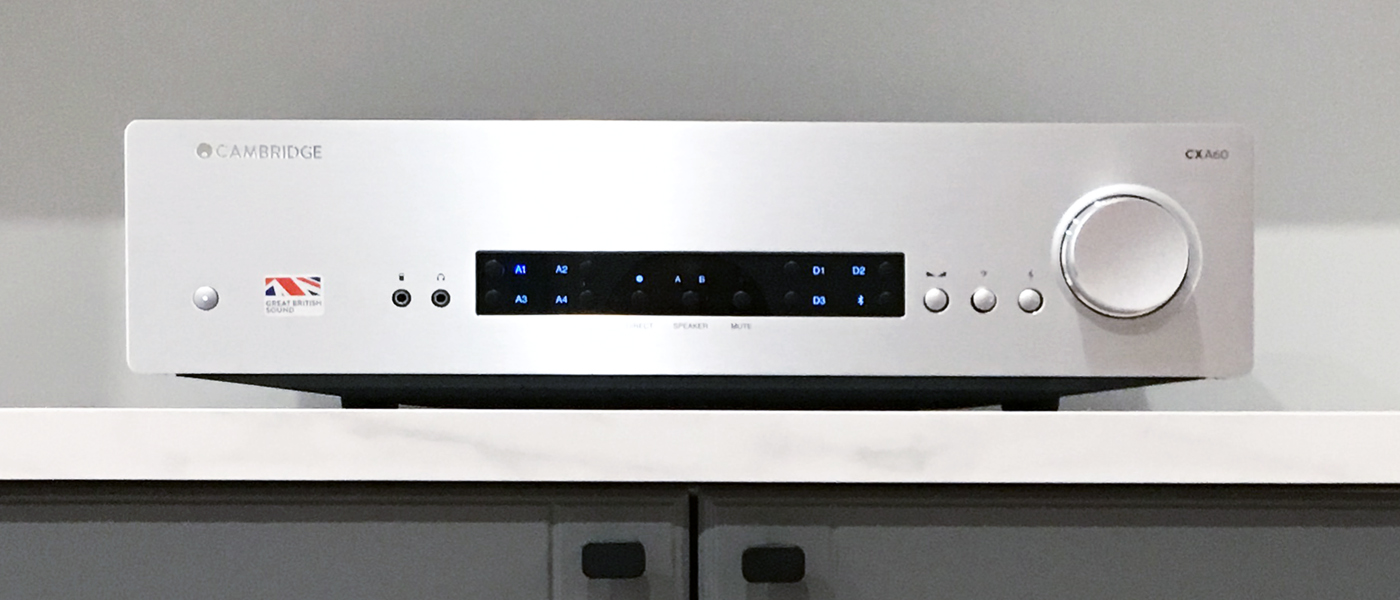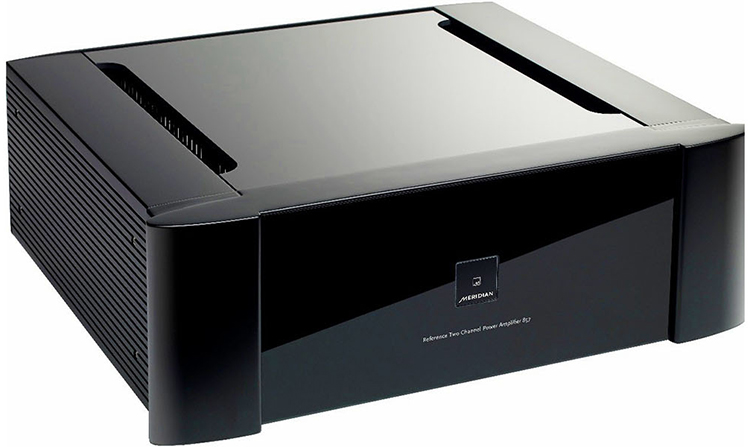
With a beautifully designed chassis of aluminum and glass, the Meridian 857 makes a bold statement; beauty and muscle can co-exist.
Meridian Audio Amplifier
- Solid, heavy construction with beautiful black glass and aluminum design
- Robust power output with low distortion
- Quality connections for both balanced and unbalanced inputs
- Soft touch power button with color coded operational information
England-based Meridian has been a cutting-edge consumer audio company since its inception back in 1977. My first experience with the Meridian brand was in a Boston high-end audio shop listening to their M1 DSP speakers with internal amplification back in my college days. The concept of keeping the signal digital all the way to the speaker was a revolutionary and novel idea back then.
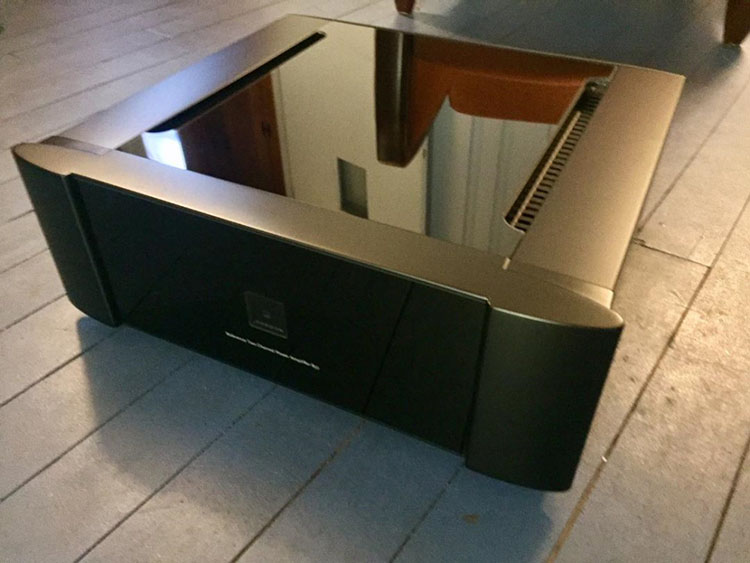
The Meridian 857 is designed and built to deliver the best possible hi-res audio performance from any high-quality passive loudspeaker system. Boasting a 1-100kHz frequency response, the Meridian 857 is designed to bring out the best from your high-resolution music files. Low-feedback construction keeps distortion to a minimum while providing music that is solid, yet transparent. The Meridian 857 amplifier is designed to provide 250 watts into 2 channels at 8 Ohms, 500 watts into 4 ohms, and is bridgeable to provide 1.5 kilowatts into a single channel at 4 Ohms.
Secrets Sponsor
Construction:
Black finish in aluminum and glass
Dedicated Rack-mount variant (4U high)
Custom Meridian Select colors also available
Inputs
2 x XLR balanced inputs
2 x RCA unbalanced inputs
Power Output:
250W RMS into 8 Ohms per channel both channels driven
500W RMS into 4 Ohms per channel both channels driven
Bridgeable to >1KW RMS into 8 Ohms or >1.5KW RMS into 4 Ohms
4 WBT terminals per side allow bi-wiring
Power Supply:
Advanced linear power supply: 100V AC 50/60 Hz, 110-120V AC 50/60Hz, 220-240V AC 50/60Hz
Control:
Trigger input [3.5mm 5-30V DC]
Cooling:
High level of passive cooling for silent in-room running
Six variable speed fans
Display:
Backlit touch-sensitive logo changes color to indicate amplifier’s status
Standby-blue, Normal Operation-green, Fans Active-amber, Overload-red
Dimensions (HxWxD):
7.7” x 18.9” x 17.6”
Weight:
77.1lbs
MSRP:
$12,000
Secrets Tags:
Meridian Audio, Meridian Audio Product, Amplifier, Meridian Audio Amplifier, Amplifier Review 2018
Company:
You would think all that juice would generate a ton of heat, but the Meridian 857 has cooling fans that automatically kick in when needed. The unit can be rack mounted with little fear of overheating. In my few weeks of auditioning this amp, I never once heard the fans kick in. The top of the amplifier was warm, but never became hot to the touch, even after hours of extended use. An open-loop configuration contributes to its overall sound quality. The design is intrinsically linear and uses error correction in the output stage to provide low output impedance. This gives the Meridian 857 excellent measured performance and a high damping factor while only applying small amounts of negative feedback.
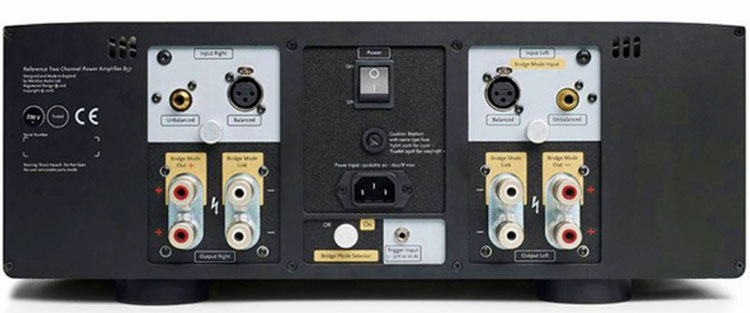
With the use of shunt feedback to eliminate common mode distortion, Meridian’s own proprietary ‘Superbal’ circuitry brings this design to the balanced input, with the ability to convert unbalanced signals to balanced as they enter the amplifier. Since my Emotiva UMC-200 preamp does not provide balanced outputs for the main right and left speaker, I am still able to obtain the benefit of keeping the signal balanced. Unfortunately, I could not perform an A/B comparison to hear any potential difference, but my music sounded great all the same in this configuration.
The Meridian 857 was shipped to my location from a dealer in the Atlanta area. It was double-boxed with a custom foam insert that provided plenty of protection from the battlefield of ground shipping. The first thing I noticed was the overall weight of the box and how thoughtful that it had side handles to help me maneuver it into the living room. At over 70 pounds, I almost threw out my back getting it in place in the second-floor media room. The 857 is not the heaviest amp I’ve used, but it is one of the most elegant.
Mine came in black, but Meridian offers custom colors if you are interested. The top and front faceplates are made of dark glass while the rest of the chassis is aluminum with a slightly curved front edge. A cleaning cloth is provided so once you set it in place, you can wipe away your smudgy fingerprints and clean the dust from the glass top when needed. In the center of the front panel resides the power button, which has a built-in soft touch feature. Around it is a light that turns blue when in stand-by, green during normal operation, orange when the cooling fans kick in, and red for overload.

During my time with the 857 I saw only the green and blue lights as I could never drive it hard enough for the fans to kick in, and I never attempted to do something as foolish as to make it go into protection mode. I really does look nice next to my other audio equipment and I had several friends walk over and admire it. It doesn’t call attention to itself, but it is easy on the eyes… and ears. It operates in total silence and whether turning on or off, it never made a sound nor made my speakers click or thump.
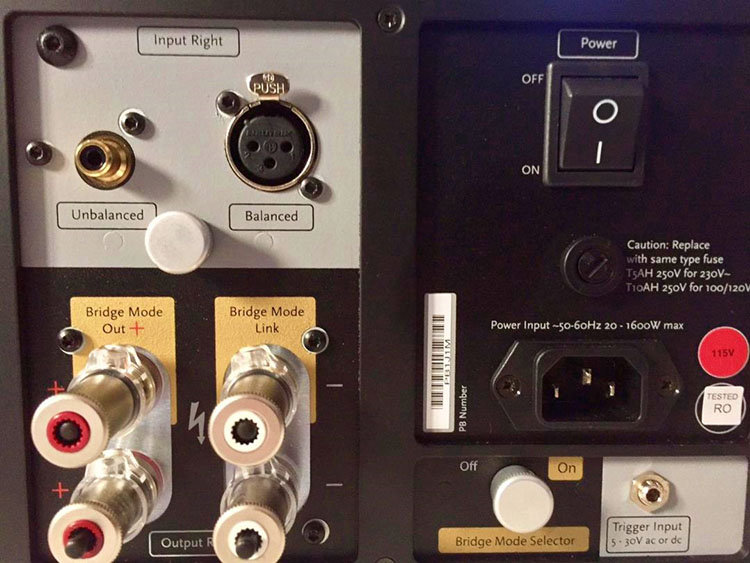
On the back side, the “business end” of the 857 as it were, there are a pair of balanced and unbalanced inputs. The main power switch is nicely located dead-center at the top for easy access. Each input has a selector switch, a bridge mode selector, and a 5-30V input trigger that will wake the 857 up when it receives a signal from a preamp.
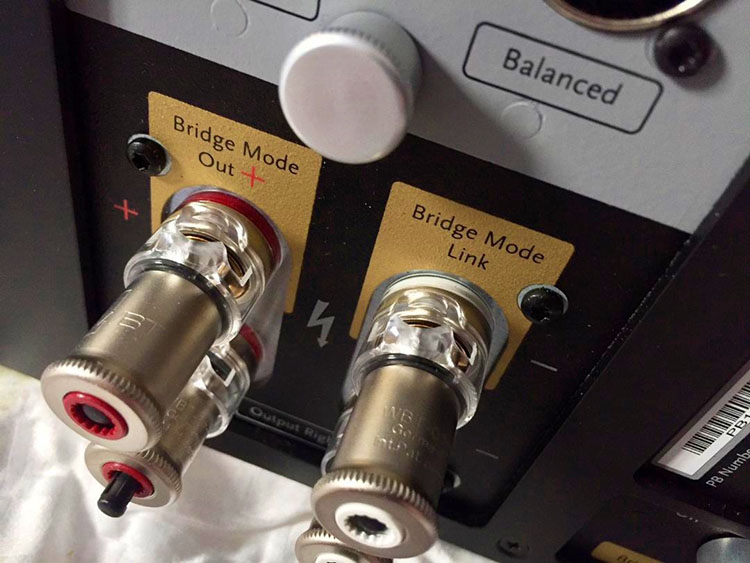
Speaker output terminals are of a very high quality, five-way binding posts that accept straight bare wire, banana, or spade connectors. The entire backplate is attached to the main chassis and has a look and feel of solidity and quality. Even the selector knobs are solid aluminum. A short, thick cable is provided should you want to bridge the outputs, and it too is well made.
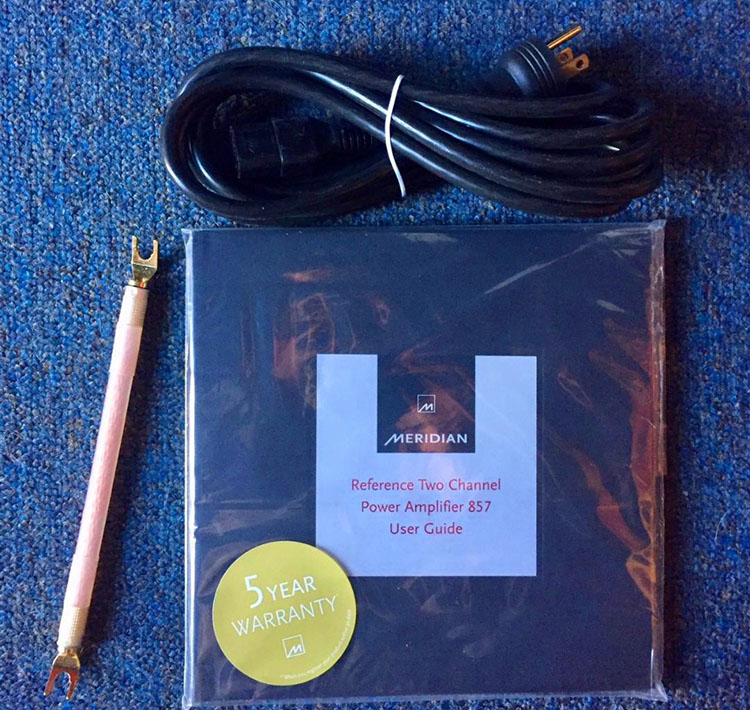
The included power cord is detachable should you wish to swap it out for an upgrade. Completing the unit is a hard cover instruction booklet and a five-year warranty. Overall, I was impressed with the fit and finish of the Meridian 857 and was surprised that an amplifier could look so stunning in glass and aluminum. Meridian took the time to build a product that reflects pride on the inside and out. After all, I have seen plenty of “functional” (a euphemism for “ugly”) audio gear over the years.
Setting up the 857 took about 10 minutes. The binding posts were spaced well apart and popping my bananas in was easy. Powering up via the touch pad on the front was effortless, as there is no pushing involved and it operates in total silence.

I ran some music through it for a day or two without doing any critical listening so the 857 could warm up and stretch its legs a bit. Once that was done, it was time to get down to business. My speakers were Revel F36s, and I listened to all my music without the aid of my Velodyne and Earthquake subs. Interconnects were Kimber Cable PBJs and the speaker cables were the 8’ length Julians from Zu Audio.
I followed the advice from Meridian to give the 857 some time to warm up and break-in before doing any real critical listening. Though I did not hear a dramatic difference from the moment I fired it up compared to the last few days I had it in my system, I usually follow this advice with any amplifier. One of the first things I noticed was the authority and solid bass that the F36s were putting out. I attribute some of this to fact that I usually cross them over to a subwoofer at 80 Hz, and normally do not hear their full potential with movies and music. I find that relegating the bass heavy-lifting to the subs relieves the amplifier from stress and generally improves power output to the Revels. Also, since my room dimensions are a bit tight, I get a smother bass response with my corner placed subs. That being said, the F36s sounded punchy, tight, and well controlled. Details in the both the midrange and treble were intact and sounded quite smooth. Turning the volume down to almost a whisper still provided the details that were in the music, whether the shimmer of strings or the tintinnabulation of a triangle playing over a brass ensemble. I was hoping to see the color ring around the power button change when the cooling fans kicked in, but that never happened, even after extended listening at high volumes. The 857 became warm to the touch, but never uncomfortably hot. The top air vents never exhausted super-heated air during play time either. My guess is that you would have to really push the 857 hard to get those six internal fans to get to work, and your ears would beg for mercy long before that happened. I would not hesitate to install the Meridian 857 in a cabinet or rack and as long as you give it a few inches of space on top to breathe; it should provide worry free operation for a long time.

For musical detail, I evaluated the Meridian 857 with Trevor Pinnock’s latest performance of Bach’s Brandenberg Concertos from the Avie label (Avie2119). My personal favorite is Concerto No. 6, due to its furious pacing and strings that chase each other around at a brisk clip in the first movement. It’s hard to believe that Bach wrote these concertos in hopes of procuring employment with the Marquis de Brandenburg and he failed to get the job.
Talk about a tough audience! (He truly was ahead of his time. ed.) I was listening for the individual players of the European Brandenburg Ensemble to hear if they sounded like a group of people playing as a single unit, or if they sound jumbled together and indistinguishable from the complex rhythm of the work. The strings sounded natural, with a sweet shimmering tone. Basso continuo was present and not over-emphasized. The ensemble had a nice openness to its sound, as though up on stage and close-miked. Conducting from the harpsichord, Pinnock played this music from years of experience and you could feel his zest and enjoyment through the energetic and sprightly sound. Impression: the Meridian 857 can play complex music with fine detail and openness without adding to or subtracting from the recording.

Moving away from strictly classical music, I picked a progressive rock band that included a classically trained keyboard artist. Emerson, Lake & Palmer’s Trilogy was recently remastered by Jakko Jakszyk, who is remastering most of King Crimson’s albums as well. Besides the 5.1 re-mix for DVD-A, a new stereo mix was done in MLP lossless 96/24. Compared to the original LP, this mix has a ton more detail, openness, and fidelity.
Vocals sounded smooth and natural with the Meridian 857 and the higher the volume, the more the music seemed to open up and unfold. Bass was punchy, especially the synth, and it never overpowered Lake’s voice in From The Beginning. Hoedown, from Aaron Copland’s ballet Rodeo, was a revelation as the old compressed recording made this sound screechy and mashed together. Now it had space for musical lines to intertwine and really get your toes tapping. Emerson could play that Moog like no other rocker before or since and you could actually believe that Copland wrote this piece for synthesizer. Impression: the 857 can rock and roll with solid bass, natural voices, acoustic, and electric sounds that approach concert levels with authority and clarity. All this, and I still couldn’t get the cooling fans to kick in!
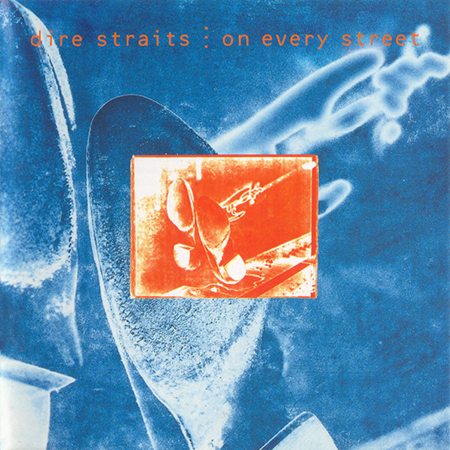
Normally, I would now turn to the pipe organ to get music with sub-bass sound to test an amplifier’s mettle, but my good friends Mark Knopfler and Dire Straits made a killer test album called On Every Street. This album has one of the best overall sound quality mixes I have ever heard. I wish it would get a re-master at a higher sample rate, but until then, this will do just fine.
Besides accurately reproducing Knopfler’s gravelly voice, his intricate guitar work is beautifully presented by the 857. The thumping synth bass on Iron Hand has a nice “punch to the gut” feel, and even though it can sound like a deep drum beat, the 857 gave its true identity up as a synthesizer. If your amp and/or speakers are not up to the challenge, this bass can be mushy and lack focused intensity. In general, I found the 857 played loud, bass-heavy music without complaint, while keeping the rest of the music in a natural perspective. Did I miss my Velodyne? Not at all.
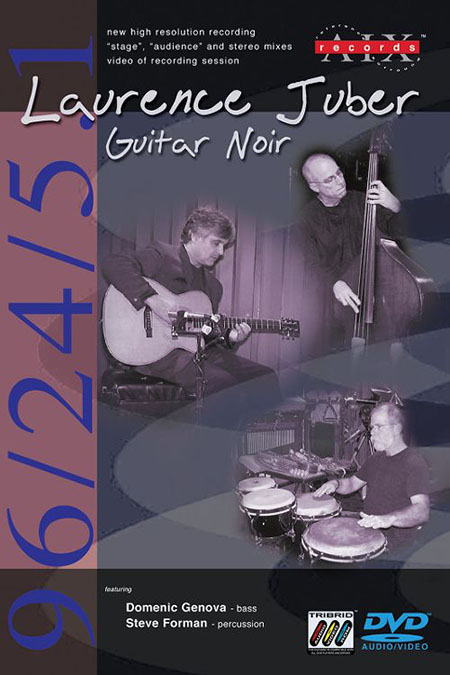
Finally, a truly good amp is not always about muscle flexing. It should maintain musical composure even when playing quietly with the volume down. The fine details of the music should not disappear just because you have turned to music that sets a mood or is designed to relax you after a long day in the salt mines. Laurence Juber is a gifted guitarist that has played with jazz ensembles and the likes of Paul McCartney and Wings, and is equally at home playing acoustic jazz as he is with an electric guitar. Guitar Noir by AIX Records is and outstanding high-resolution recording (96/24) with both stereo and surround mixes.
The mixes also can be with the listener in the front row of the audience or on stage with the performers. The up-close miking of plucked strings is very enjoyable to hear and this album has found its way to my ears often. It also includes video, so you can sit back, listen, and watch the show. The 857 presented the guitar in all its natural and expressive glory. Even bass notes had a weight and solidity that made it feel “live”. You could occasionally hear the scraping of a finger along the fret and subtle drumming of the thumb on the board. Impression: the Meridian 857 captures the beauty of the musical details and presents the music with a solid, wide soundstage.
Secrets Sponsor
I played a lot of music during my time with the Meridian 857, because I found it to be dead quiet between tracks and explosively dynamic yet neutral when playing music. One of the joys of reviewing audio equipment is the ability to hear your music in a fresh new light and comparing your own gear against Brand X in the comfort of your own music room. I feel the Meridian 857 stands out with its nice visual design, cool operation, and seemingly infinite power reserves. I may not need this kind of amplification, but I sure could desire it.
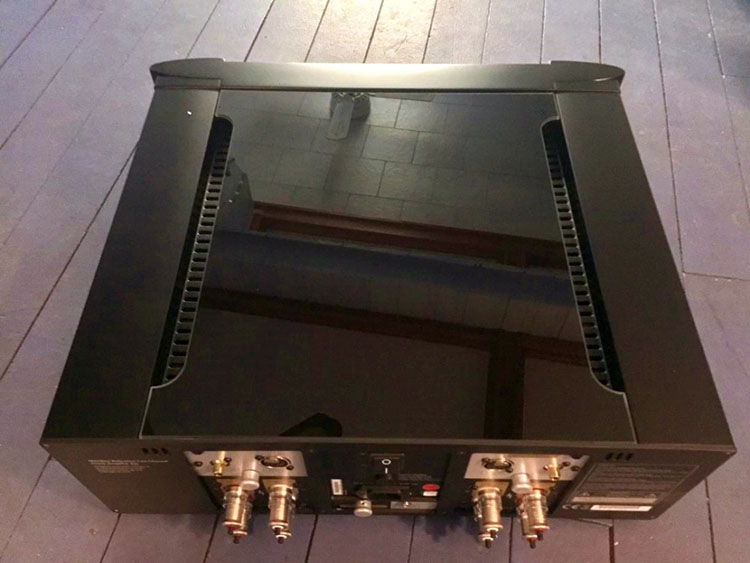

THE MERIDIAN REFERENCE TWO CHANNEL POWER AMPLIFIER 857 is a substantial investment that demonstrates that good looks and exceptional performance can go hand in hand.
- Eye-catching design with glass and aluminum
- Powerful enough, yet bridgeable to 1.5 kilowatts!
- Clean and natural sound reproduction
- Detailed, solid construction
- Alexa integration? (maybe not)
The Meridian 857 is certainly one of the nicest looking amplifiers I have seen, but its power reserves make it both Beauty and the Beast. Kudos to the Meridian team for designing an amplifier that makes us want to reacquaint ourselves with our music. Meridian has created an amplifier that demonstrates their finest ideals for an audio product. It is certainly one of the nicest looking amplifiers I have auditioned, as most other amps look like plain metal boxes compared to the rest of our components. The real trick was to add clean, unadulterated muscle that can turn the 857 into an astonishingly powerful mono-block. If this is their statement, I heard it loud and clear!


